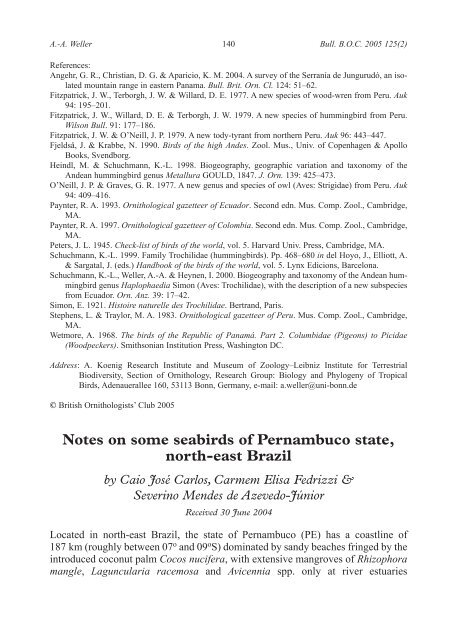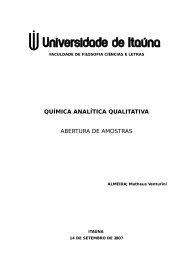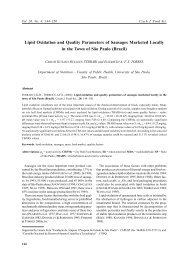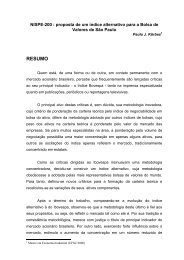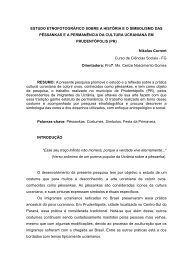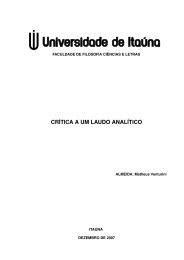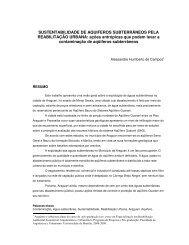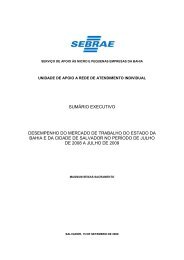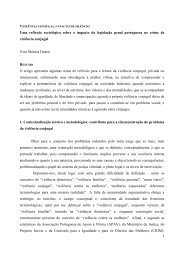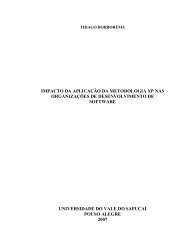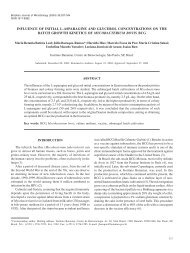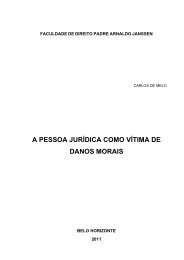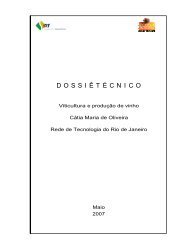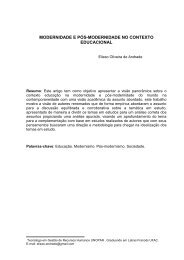Print boc1252-050510.qxd - Uol
Print boc1252-050510.qxd - Uol
Print boc1252-050510.qxd - Uol
Create successful ePaper yourself
Turn your PDF publications into a flip-book with our unique Google optimized e-Paper software.
Mac Version 19/5/05 12:21 pm Page 140<br />
A.-A. Weller<br />
140<br />
References:<br />
Angehr, G. R., Christian, D. G. & Aparicio, K. M. 2004. A survey of the Serranía de Jungurudó, an isolated<br />
mountain range in eastern Panama. Bull. Brit. Orn. Cl. 124: 51–62.<br />
Fitzpatrick, J. W., Terborgh, J. W. & Willard, D. E. 1977. A new species of wood-wren from Peru. Auk<br />
94: 195–201.<br />
Fitzpatrick, J. W., Willard, D. E. & Terborgh, J. W. 1979. A new species of hummingbird from Peru.<br />
Wilson Bull. 91: 177–186.<br />
Fitzpatrick, J. W. & O’Neill, J. P. 1979. A new tody-tyrant from northern Peru. Auk 96: 443–447.<br />
Fjeldså, J. & Krabbe, N. 1990. Birds of the high Andes. Zool. Mus., Univ. of Copenhagen & Apollo<br />
Books, Svendborg.<br />
Heindl, M. & Schuchmann, K.-L. 1998. Biogeography, geographic variation and taxonomy of the<br />
Andean hummingbird genus Metallura GOULD, 1847. J. Orn. 139: 425–473.<br />
O’Neill, J. P. & Graves, G. R. 1977. A new genus and species of owl (Aves: Strigidae) from Peru. Auk<br />
94: 409–416.<br />
Paynter, R. A. 1993. Ornithological gazetteer of Ecuador. Second edn. Mus. Comp. Zool., Cambridge,<br />
MA.<br />
Paynter, R. A. 1997. Ornithological gazetteer of Colombia. Second edn. Mus. Comp. Zool., Cambridge,<br />
MA.<br />
Peters, J. L. 1945. Check-list of birds of the world, vol. 5. Harvard Univ. Press, Cambridge, MA.<br />
Schuchmann, K.-L. 1999. Family Trochilidae (hummingbirds). Pp. 468–680 in del Hoyo, J., Elliott, A.<br />
& Sargatal, J. (eds.) Handbook of the birds of the world, vol. 5. Lynx Edicions, Barcelona.<br />
Schuchmann, K.-L., Weller, A.-A. & Heynen, I. 2000. Biogeography and taxonomy of the Andean hummingbird<br />
genus Haplophaedia Simon (Aves: Trochilidae), with the description of a new subspecies<br />
from Ecuador. Orn. Anz. 39: 17–42.<br />
Simon, E. 1921. Histoire naturelle des Trochilidae. Bertrand, Paris.<br />
Stephens, L. & Traylor, M. A. 1983. Ornithological gazetteer of Peru. Mus. Comp. Zool., Cambridge,<br />
MA.<br />
Wetmore, A. 1968. The birds of the Republic of Panamá. Part 2. Columbidae (Pigeons) to Picidae<br />
(Woodpeckers). Smithsonian Institution Press, Washington DC.<br />
Address: A. Koenig Research Institute and Museum of Zoology–Leibniz Institute for Terrestrial<br />
Biodiversity, Section of Ornithology, Research Group: Biology and Phylogeny of Tropical<br />
Birds, Adenauerallee 160, 53113 Bonn, Germany, e-mail: a.weller@uni-bonn.de<br />
© British Ornithologists’ Club 2005<br />
Bull. B.O.C. 2005 125(2)<br />
Notes on some seabirds of Pernambuco state,<br />
north-east Brazil<br />
by Caio José Carlos, Carmem Elisa Fedrizzi &<br />
Severino Mendes de Azevedo-Júnior<br />
Received 30 June 2004<br />
Located in north-east Brazil, the state of Pernambuco (PE) has a coastline of<br />
187 km (roughly between 07 o and 09 o S) dominated by sandy beaches fringed by the<br />
introduced coconut palm Cocos nucifera, with extensive mangroves of Rhizophora<br />
mangle, Laguncularia racemosa and Avicennia spp. only at river estuaries
Mac Version 19/5/05 12:21 pm Page 141<br />
Caio José Carlos et al.<br />
141<br />
Bull. B.O.C. 2005 125(2)<br />
(CONDEPE 1982, FIDEN 1987). The coastal climate is hot with a mean annual<br />
temperature of 25.5 o C, and mean annual rainfall of 152.3 mm (INMET 2003).<br />
The coast is important for various birds, mainly migrant shorebirds and terns<br />
that use the region as wintering and stopover areas (Azevedo-Júnior & Larrazábal<br />
2002, Fedrizzi 2003). However, except for a few studies in the Fernando de<br />
Noronha archipelago (currently part of PE) (e.g. Nacinovic & Teixeira 1987) and in<br />
the north of the state (Azevedo-Júnior 1998), very little research has focused on the<br />
seabirds that occur in PE.<br />
Here we review the distribution and present new data for some seabirds of PE,<br />
based on the literature, specimens in the ornithological collection of the<br />
Universidade Federal de Pernambuco (UFPE) and our own field work. For<br />
simplicity, we list geographical coordinates, some of them taken from Paynter &<br />
Traylor (1991), for each locality only on its first mention in the text. English names<br />
and taxonomic sequence follow del Hoyo et al. (1992, 1996), except for Atlantic<br />
Yellow-nosed Albatross Thalassarche chlororhynchos, where we follow Robertson<br />
& Nunn (1998). Biometrics (mm) of specimens are: exposed culmen (ec), total<br />
culmen (tc), wing length (wl), tarsus (tr), tail (ta) and total length (tl).<br />
Species accounts<br />
MAGELLANIC PENGUIN Spheniscus magellanicus<br />
A common visitor to southern Brazil (Rio Grande do Sul) during the austral winter,<br />
which occasionally reaches north to Rio de Janeiro, with vagrants recorded north to<br />
Bahia (Sick 1997) and Alagoas (F. J. M. Pinto in Teixeira et al. 1988). The Jornal<br />
do Comércio, a local newspaper, noted an immature found alive at Itamaracá Island<br />
(c.07o45’S, 34o51’W) on 13 August 1999, which appears to be the northernmost<br />
record for this species in the Atlantic.<br />
ATLANTIC YELLOW-NOSED ALBATROSS Thalassarche chlororhynchos<br />
T. chlororhynchos is a globally threatened species (Endangered) which breeds on<br />
Gough and Tristan da Cunha (BirdLife International 2000), and is one of the<br />
commonest albatrosses off the Brazilian coast (Grantsau 1995). Coelho (1978)<br />
mentioned a record for PE, but did not provide the source, date or locality. It was<br />
based on a specimen (UFPE 799; juvenile; ec 117.75, tc 132.46, wl 495, tr 79.31,<br />
ta 170, tl 800) found alive at Maria Farinha beach (c.07 o 40’S, 34 o 50’W),<br />
municipality of Paulista, on 19 May 1978. Additionally, another juvenile found in<br />
PE (locality and date unknown) was sent to Recife Zoo, and is currently on display<br />
at the Natural History Museum of the Environmental Education Centre there.<br />
ANTARCTIC PRION Pachyptila desolata<br />
Although treated as a subspecies of Broad-billed Prion Pachyptila vittata (e.g.<br />
Harrison 1985), many recent authors (e.g. del Hoyo et al. 1992) consider it a<br />
species. Coelho (1978) reported its presence in PE, but did not mention a source,<br />
locality or date. The record was based on a specimen (UFPE 358; male; ec 26.92,
Mac Version 19/5/05 12:21 pm Page 142<br />
Caio José Carlos et al.<br />
142<br />
Bull. B.O.C. 2005 125(2)<br />
tc 34.50, wl 195, tr 30.94, ta 95, tl 285; collected by A. Cruz) found at Tamandaré<br />
beach (c.8 o 36’S, 35 o 07’W), municipality of Rio Formoso, on 25 July 1978. Further<br />
records from Guadalupe Environmental Protection Area (c.08 o 48’S, 35 o 07’W), in<br />
the municipalities of Tamandaré and Barreiros (Neves et al. 2000) were, in fact,<br />
based on the same UFPE specimen.<br />
CORY’S SHEARWATER Calonectris (diomedea) borealis<br />
This Palearctic migrant occurs off Brazil en route to and from wintering areas off<br />
southern South America (Vooren & Fernandes 1989, Sick 1997). Azevedo-Júnior<br />
(1991) reported two dead birds at Boa Viagem beach (c.08 o 07’S, 34 o 53’W), Recife,<br />
one of which (UFPE 3406; female; ec 45.35, tc 60.07, wl 370, tr 48.65, ta 141, tl<br />
498; collected by S. M. de Azevedo-Júnior, 2 September 1990) is currently held in<br />
UFPE. In addition, UFPE obtained one (3404; female; ec 56.40, tc 68.33, wl 350,<br />
tr 54.10, tl 140; collected by S. M. de Azevedo-Júnior) from Tamandaré beach on<br />
21 January 1991, and another (3405; male; ec 46.63, tc 61.85, wl 360, tr 54.29, ta<br />
131, tl 470; collected by S. M. de Azevedo-Júnior) from Coroa do Avião (07 o 40’S,<br />
34 o 50’W), municipality of Igarassu in July 1991.<br />
MANX SHEARWATER Puffinus puffinus<br />
Manx Shearwater occurs off the Brazilian coast en route to and from the wintering<br />
grounds off southern South America (Sick 1997). There is only one published<br />
record from PE, of one flying over the Coroa do Avião on 3 May 1992 (Azevedo-<br />
Júnior 1998). At the same locality, one (UFPE 3985; male; ec 34.2, wl 260, tr 42.2,<br />
ta 81; collected by S. M. Azevedo-Júnior) was mist-netted on 16 November 2003.<br />
GREATER SHEARWATER Puffinus gravis<br />
Coelho (1978) mentioned this shearwater for PE, without source, locality or date.<br />
The record was based on a specimen (UFPE 841; male; ec 44.19, tc 56.19, wl 312,<br />
tr 56.11, ta 110, tl 505; collected by A. G. M Coelho) found at Ponta de Pedras<br />
beach (c.07 o 41’S, 34 o 53’W), municipality of Goiana on 20 July 1978. Azevedo-<br />
Júnior (1991) reported 12 specimens found dead at Boa Viagem beach, of which<br />
two (3400; male; ec 45.94, tc 53.29, wl 315, tr 59.21, ta 120; and 3402; unsexed;<br />
ec 43.63, tc 50.16, wl 320, tr 54.24, ta 105; both collected by S. M. Azevedo-Júnior,<br />
in May 1990) are in UFPE. In addition, UFPE has one (949; unsexed; ec 49.11, tc<br />
57.67, wl 350, tr 57.58, ta 100; collected by A. G. M Coelho) from Olinda<br />
(c.08 o 01’S, 34 o 51’W) in June 1980.<br />
MASKED BOOBY Sula dactylatra<br />
In Brazil, this booby breeds on offshore islands such as the Abrolhos, Fernando de<br />
Noronha and Atol das Rocas (Sick 1997). Azevedo-Júnior (1994) reported a<br />
specimen, originally banded (V-18954) on 17 December 1992 in the Biological<br />
Reserve of Atol das Rocas (c.03 o 45–03 o 56’S, 33 o 37’W), found alive at Gaibú beach<br />
(c.08 o 05’S, 34 o 51’W), municipality of Cabo de Santo Agostinho, on 12 August<br />
1993. UFPE also obtained one (3684; juvenile; tc 96.43, wl 440, tr 44.14, ta 150, tl
Mac Version 19/5/05 12:21 pm Page 143<br />
Caio José Carlos et al.<br />
143<br />
Bull. B.O.C. 2005 125(2)<br />
750; collected by S. M. Azevedo-Júnior) from Boa Viagem beach on 16 April 2001.<br />
According to del Hoyo et al. (1992), young disperse extensively, but most adults<br />
are present year-round in the vicinity of colonies, presumably explaining the<br />
apparently accidental occurrence of juveniles in PE.<br />
BROWN BOOBY Sula leucogaster<br />
Previous PE records involved two observed off a reef at Recife in March 1943<br />
(Lamm 1948), and a record reported by Coelho (1978) without precise locality or<br />
date. According to Coelho (in litt. 2003), this was based on some individuals he<br />
observed at Olinda, but he could not recall the date. Adults tend to stay around<br />
colonies, while young and non-breeders disperse widely (del Hoyo et al. 1992). The<br />
age of those individuals recorded in PE could not be determined, but they were<br />
probably juveniles on dispersal.<br />
MAGNIFICENT FRIGATEBIRD Fregata magnificens<br />
Lamm (1948) and Coelho (1978) mentioned the species’ occurrence in PE, but did<br />
not provide localities or dates. According to Coelho (in litt. 2003) his record was<br />
based on some individuals he observed at Olinda on 7 July 1977. Azevedo-Júnior<br />
(1998) reported a juvenile flying over Coroa do Avião on 20 December 1988. Two<br />
juveniles were seen at the same locality on 27 February and 22 September 2003<br />
(CJC & CEF). In addition, three were seen over Itamaracá Island on 23 August<br />
2003 (CJC & CEF).<br />
SOUTH POLAR SKUA Catharacta maccormicki<br />
This transequatorial migrant breeds on the Antarctic continent and peninsula, and<br />
moves north in the non-breeding period as far as Alaska and Greenland (del Hoyo<br />
et al. 1996). Coelho (1977) reported one, originally banded (567.61211) at Ross<br />
Island (Antarctica) that escaped from Baltimore Zoo (USA) on 3 December 1969,<br />
and was caught by fishermen on 4 December 1970, 15 miles off Recife. Lara-<br />
Resende & Leal (1982) noted one, probably recovered in PE, but did not provide a<br />
precise locality, date or band number. UFPE obtained a dark morph (3137; male; ec<br />
44.81, tc 53.40, wl 400, tr 59.84, ta 155, tl 600) caught by fishermen at Porto de<br />
Galinhas beach (c.08 o 24’S, 35 o 04’W), municipality of Ipojuca on 14 April 2000.<br />
POMARINE SKUA Stercorarius pomarinus<br />
A Holarctic migrant that winters at sea, mainly between the Tropic of Cancer and<br />
the equator, and off Australia (del Hoyo et al. 1996, Wiley & Lee 2000). In Brazil,<br />
it is known from São Paulo, Rio Grande do Sul, and from one record near the mouth<br />
of the rio Tapajós, Pará (Olmos 2000). On 22 May 2003, a dark morph was<br />
observed pursuing Common Sterna hirundo and Cayenne Terns Thalasseus<br />
sandvicensis eurygnathus near Coroa do Avião (CJC & CEF), the first record in<br />
north-east Brazil. According to Wiley & Lee (2000), return migration commences<br />
in mid April and extends to early June.
Mac Version 19/5/05 12:21 pm Page 144<br />
Caio José Carlos et al.<br />
144<br />
Bull. B.O.C. 2005 125(2)<br />
SANDWICH TERN Thalasseus sandvicensis acuflavidus<br />
The first record from PE was reported by Lamm (1948), and consisted of a few<br />
individuals in a mixed flock with Common Terns Sterna hirundo near Recife on 8<br />
October 1944 for several days. Thereafter there were no state records until up to<br />
four were seen at Coroa do Avião on 22–24 May, 19 July, 24 August and 22<br />
September 2003, in mixed flocks with Cayenne T. s. eurygnathus and Common<br />
Terns (CJC & CEF). According to Voous (1977), misidentification involving the<br />
similar Cayenne Tern is common, as the two may flock together, at least in northeast<br />
Brazil (Teixeira et al. 1988, Sick 1997). However, Sandwich Tern is smaller<br />
and has an obvious black bill (from the base) with a small yellow tip, whilst<br />
Cayenne Tern may have a black bill but always has some yellow at the base and/or<br />
along the gonys (e.g. Junge & Voous 1955).<br />
ROSEATE TERN Sterna dougallii<br />
This tern breeds in North America, the Azores and north-west Europe. Wintering<br />
Roseate Terns in South America are primarily of North American origin (del Hoyo<br />
et al. 1996), but birds from the Azores have been caught in Bahia (Hays et al. 1997,<br />
1999). Lara-Resende & Leal (1982) reported a specimen banded in North America<br />
that was recovered in PE, but did not provide a precise locality, date or band<br />
number. A juvenile was mist-netted at Coroa do Avião on 24 October 2003<br />
(SMAZ). Measurements were: ec 28.9, wl 246, tr 12.5 and ta 110. It was moulting<br />
the fourth primary.<br />
LEAST TERN Sterna antillarum<br />
Breeds in eastern North America, Honduras and the Caribbean to north Venezuela,<br />
and winters in north Brazil (del Hoyo et al. 1996), but has been recorded south to<br />
Rio de Janeiro (Sick 1997). A juvenile (UFPE 3986; ec 25, wl 158, tr 16 and ta 64;<br />
weight 40 g; collected by S. M. Azevedo-Júnior) was mist-netted at Coroa do Avião<br />
on 26 October 2003.<br />
YELLOW-BILLED TERN Sterna superciliaris<br />
Restricted to South America, where it inhabits rivers, lakes and estuaries (Harrison<br />
1985, del Hoyo et al. 1996). One was mist-netted at Coroa do Avião in October<br />
1992 (Azevedo-Júnior 1998). At the same locality, an adult was observed foraging<br />
with a flock of Common Terns S. hirundo, and roosting on a sandbar with various<br />
shorebirds, on 21 June 2003 (CEF).<br />
Concluding remarks<br />
Besides such residents as boobies, frigatebirds and terns, the seabird community in<br />
PE (including the Fernando de Noronha archipelago), as well as elsewhere in northeast<br />
Brazil, includes (1) boreal migrants (e.g. Cory’s Sheawater), en route to and<br />
from their wintering areas in southern South America; and (2) Southern Ocean birds<br />
(e.g. Atlantic Yellow-nosed Albatross), undertaking northward movements along
Mac Version 19/5/05 12:21 pm Page 145<br />
Caio José Carlos et al.<br />
145<br />
Bull. B.O.C. 2005 125(2)<br />
the Brazilian coast in the austral winter. Pelagic taxa are more common in<br />
April–May, when some may be found dead on beaches (Lamm 1948, Azevedo-<br />
Júnior 1991, this work). According to Olmos et al. (1995), strong winds associated<br />
with cold fronts originating in Antarctica may be important in explaining this<br />
phenomenon of seasonal mass mortality on the north-east Brazilian coast.<br />
Another point to stress is that there are few studies of seabird distribution off<br />
north-east Brazil. Antas (1991) noted that ornithologists interested in seabirds are<br />
mainly resident in southern Brazil, and the lack of seabird studies in PE may<br />
explain the relative lack of records of common taxa such as Manx Shearwater and<br />
Sandwich Tern. Continuous surveys will probably reveal that both Northern<br />
Hemisphere and Southern Ocean breeders are more common in the region than<br />
previously supposed.<br />
The occurrence of seabirds in a region dominated by sandy beaches and where<br />
the sea is oligotrophic is apparently linked to the high supply of nutrients from<br />
mainland ecosystems such as estuaries and associated mangroves, e.g. the mouth of<br />
the rio São Francisco, in Alagoas (Sousa 1993), and Mangue Seco, in Bahia (Hays<br />
et al. 1999). Furthermore, some near-shore shelf breaks are also important in<br />
recycling nutrients (Olmos 2001).<br />
The Canal de Santa Cruz estuarine complex (including Itamaracá Island and<br />
Coroa do Avião islet), with its five river estuaries and c.32 km 2 of mangrove<br />
swamps (Barros et al. 2000) may be another relatively productive area, and it is<br />
unsurprising that most seabird records from PE are from this region, although it<br />
should be noted the area is near a large urban centre (Recife) and field surveys have<br />
been concentrated there. Thus far, 47 waterbird taxa have been recorded in this<br />
complex (Azevedo-Júnior 1998, Fedrizzi 2003, this work), and it was recently<br />
listed as important for Brazilian seabird conservation (MMA 2002). Despite its<br />
biological importance, the region suffers from uncontrolled tourism, and urban and<br />
industrial pollution. Urgent efforts must be made to ensure effective conservation<br />
for the Canal de Santa Cruz environment and its birds.<br />
Acknowledgements<br />
We are grateful to Jeremiah Trimble and Drs Yoshika Oniki and Edwin Willis for reviewing the<br />
manuscript. Branyl Com. & Ind. Têxtil Ltd. partially supported studies by CJC in 2003. CEF and CJC<br />
respectively received a doctoral and master’s scholarship from the Fundação de Aperfeiçoamento de<br />
Pessoal de Nível Superior (CAPES).<br />
References:<br />
Antas, P. de T. Z. 1991. Status and conservation of seabirds in Brazilian waters. Pp. 140–158 in Croxall,<br />
J. P. (ed.) Seabird status and conservation: a supplement. International Council for Bird<br />
Preservation, Cambridge, UK.<br />
Azevedo-Júnior, S. M. 1991. Mortandades de aves oceânicas no Nordeste brasileiro—maio e junho de<br />
1990. In I Congresso Brasileiro de Ornitologia. Resumos. MCT-CNPq/Museu Paraense Emílio<br />
Goeldi, Belém.<br />
Azevedo-Júnior, S. M. 1994. Primeiro registro das aves oceânicas Sula dactylatra, Sterna fuscata e<br />
Anous stolidus na costa de Pernambuco, Brasil. In IV Congresso Brasileiro de Ornitologia.<br />
Resumos. Universidade Federal Rural de Pernambuco, Recife.
Mac Version 19/5/05 12:21 pm Page 146<br />
Caio José Carlos et al.<br />
146<br />
Bull. B.O.C. 2005 125(2)<br />
Azevedo-Júnior, S. M. 1998. As aves do Canal de Santa Cruz, Pernambuco, Brasil. Cad. Ômega Univ.<br />
Fed. Rural de Pernambuco, Sér. Biol. 5: 35–50.<br />
Azevedo-Júnior, S. M. & Larrazábal, M. E. 2002. Migração de aves em Pernambuco. Pp. 623–630 in<br />
Silva, J. M. C. & Tabarelli, M. (eds.) Diagnóstico da biodiversidade de Pernambuco, vol. 2. Ed.<br />
Massangana, Recife.<br />
Barros, H. M., Eskinazi-Leça, E., Macedo, S. J. & Lima, T. 2000. Gerenciamento participativo de<br />
estuários e manguezais. Ed. Universitária, Recife.<br />
BirdLife International. 2000. Threatened birds of the world. BirdLife International, Cambridge, UK &<br />
Lynx Edicions, Barcelona.<br />
Coelho, A. G. M. 1977. On the South Polar Skua Catharacta skua maccormicki recaptured in<br />
Pernambuco, Brazil. Not. Biol. 2: 1.<br />
Coelho, A. G. M. 1978. Lista de algumas espécies de aves do nordeste do Brasil. Not. Biol., n.s. 1: 1–7.<br />
CONDEPE (Conselho de Desenvolvimento de Pernambuco). 1982. Estudo para controle ambiental nas<br />
áreas estuarinas de Pernambuco, Canal de Santa Cruz. CONDEPE, Recife.<br />
Fedrizzi, C. E. 2003 Abundância sazonal e biologia de aves costeiras na Coroa do Avião, Pernambuco,<br />
Brasil. M.Sc. dissertation. Universidade Federal de Pernambuco, Recife.<br />
FIDEN (Fundação de Desenvolvimento da Região Metropolitana do Recife). 1987. Proteção das áreas<br />
estuarinas. FIDEN, Recife.<br />
Grantsau, R. 1995. Os albatrozes (Diomedeidae, Procellariiformes) do Atlântico e suas ocorrências na<br />
costa brasileira e uma chave de identificação. Bol. CEO 12: 20–31.<br />
Harrison, P. 1985. Seabirds: an identification guide. Croom Helm, Beckenham.<br />
Hays, H., DiCostanzo, J., Cormons, G., Antas, P. de T .Z., Nascimento, J. L. X., Nascimento I. L. S. &<br />
Bremer, R. E. 1997. Recoveries of Roseate and Common Terns in South America. J. Field Orn. 68:<br />
79–90.<br />
Hays, H., Lima, P. C., Monteiro, L., DiCostanzo, J., Cormons, G., Nisbet, I. C. T., Saliva, J. E.,<br />
Spendelow, J. A., Burger, J., Pierce, J. & Gochfeld, M. 1999. A nonbreeding concentration of<br />
Roseate and Common Terns in Bahia, Brazil. J. Field Orn. 70: 455–464.<br />
del Hoyo, J., Elliott, A. & Sargatal, J. (eds.) 1992. Handbook of the birds of the world, vol. 1. Lynx<br />
Edicions, Barcelona.<br />
del Hoyo, J., Elliott, A. & Sargatal, J. (eds.) 1996. Handbook of the birds of the world, vol. 3. Lynx<br />
Edicions, Barcelona.<br />
INMET (Instituto Nacional de Meteorologia). 2003. Normal climatológica da região metropolitana do<br />
Recife (1962–1990). INMET, Brasília.<br />
Junge, G. C. A. & Voous, K. H. 1955. The distribution and the relationship of Sterna eurygnatha<br />
Saunders. Ardea 43: 226–247.<br />
Lamm, D. W. 1948. Notes on the birds of Pernambuco and Paraíba, Brazil. Auk 65: 261–283.<br />
Lara-Resende, S. M. & Leal, R. P. 1982. Recuperação de anilhas estrangeiras no Brasil. Brasil Florestal<br />
52: 27–53.<br />
MMA (Ministério do Meio Ambiente). 2002. Avaliação e identificação de áreas e ações prioritárias<br />
para a conservação, utilização sustentável e repartição dos benefícios da biodiversidade nos biomas<br />
brasileiros. MMA, Brasília.<br />
Nacinovic, J. B. & Teixeira, D. M. 1987. As aves de Fernando de Noronha: uma lista sistemática anotada.<br />
Rev. Brasil. Biol. 49: 709–729.<br />
Neves, R. M. L., Telino-Júnior, W. R., Rodrigues, R. C. & Botelho, M. N. 2000. Caracterização e avaliação<br />
da população avifaunística da Área de Proteção Ambiental de Guadalupe. Prodetur/PE &<br />
CPRH, Recife.<br />
Olmos, F., Martuscelli, P., Silva e Silva, R. & Neves, T. 1995. The seabirds of São Paulo, southeastern<br />
Brazil. Bull. Brit. Orn. Cl. 115: 117–128.<br />
Olmos, F. 2000. Revisão dos registros de Stercorarius pomarinus no Brasil, com notas sobre registros de<br />
S. longicaudus e S. parasiticus (Charadriiformes: Stercorariidae). Nattereria 1: 29–33.<br />
Olmos, F. 2002. Non-breeding seabirds in Brazil: a review of band recoveries. Ararajuba 10: 31–42.<br />
Paynter, R. A. & Traylor, M. A. 1991. Ornithological gazetteer of Brazil. Mus. Comp. Zool., Cambridge,<br />
MA.
Mac Version 19/5/05 12:21 pm Page 147<br />
Caio José Carlos et al.<br />
147<br />
Robertson, C. J. R. & Nunn, G. B. 1998. Towards a new taxonomy for albatrosses. Pp. 13–19 in<br />
Robertson, C. J. R. & Gales, R. (eds.) Albatross biology and conservation. Chipping Norton, Beatty<br />
Press.<br />
Sick, H. 1997. Ornitologia brasileira. Ed. Nova Fronteira, Rio de Janeiro.<br />
Sousa, M. C. 1993. Sobre aves marinhas no litoral do estado de Sergipe e Alagoas. In III Congresso<br />
Brasileiro de Ornitologia. Resumos. Universidade Católica de Pelotas/Sociedade Brasileira de<br />
Ornitologia, Pelotas.<br />
Teixeira, D. M., Nacinovic, J. B. & Luigi, G. 1988. Notes on some birds of northeastern Brazil. Bull.<br />
Brit. Orn. Cl. 108: 75–79.<br />
Wiley, R. H. & Lee, D. S. 2000. Pomarine Jaeger (Stercorarius pomarinus). In Poole, A. & Gill, F. (eds.)<br />
The birds of North America, no. 483. The Birds of North America, Philadelphia, PA.<br />
Vooren, C. M. & Fernandes, A. C. 1989. Guia de albatrozes e petréis do sul do Brasil. Ed. Sagra, Porto<br />
Alegre.<br />
Voous, K. H. 1977. Natterer’s specimens of Sterna cantiaca from Brazil. Bull. Brit. Orn. Cl. 97: 42–44.<br />
Addresses: Caio José Carlos (corresponding author) & Carmem Elisa Fedrizzi, Laboratório de<br />
Elasmobrânquios e Aves Marinhas, Departamento de Oceanografia, Fundação Univ. Fed. do Rio<br />
Grande, CP 474, Rio Grande, RS, CEP 96201-900, Brazil, e-mails: cajoca@uol.com.br and<br />
cefedrizzi@uol.com.br. Severino Mendes de Azevedo-Júnior, Departamento de Zoologia,<br />
Universidade Federal de Pernambuco, Avenida Professor Moraes Rego 1235, Cidade<br />
Universitária, Recife, PE, CEP 50670-420, Brazil, e-mail: smaj@ufpe.br<br />
© British Ornithologists’ Club 2005<br />
Bull. B.O.C. 2005 125(2)<br />
On the type locality of the Cordilleran Buzzard<br />
Buteo poecilochrous<br />
by J. Cabot & T. de Vries<br />
Received 21 July 2004<br />
In describing the type locality of Buteo poecilochrous, Gurney (1870) mentioned<br />
that the bird came from Yauayacu in Ecuador and that the specimen was sent, in<br />
1877, from Ecuador to Messrs. Salvin & Godman in London by a certain Mr<br />
Buckley.<br />
Hellmayr & Conover (1949) claimed that Yauayacu is in fact a transcription<br />
error, and the real name of the site in Ecuador is Yanayacu. Vaurie (1962)<br />
questioned this conclusion and stated that the type locality of B. poecilochrous<br />
corresponds to a place named Sarayacu. Vaurie (1962) based this on the fact that<br />
Buckley’s collectors established camp in this place (also currently known as<br />
Pacayacu on some maps), on the eastern slope of the Andes (01º34’S, 77º30’W) at<br />
1,500 m, south of Canelos on the río Bobonaza. Vaurie (1962) also claimed that<br />
Yanayacu is in truth on the río Corrientes in Peru (03º02’S, 75º15’W).<br />
Nevertheless, the same author also believed that Sarayacu is too low for the<br />
Puna Buzzard to be found, since this species is typical of the high Andes, and it was<br />
possibly captured at higher altitude. Chapman (1926) also suggested this and stated


